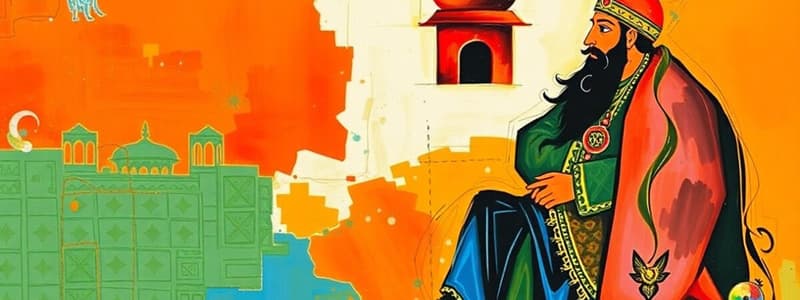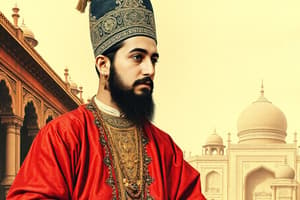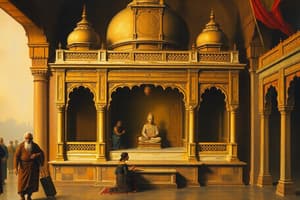Podcast
Questions and Answers
What marked the end of the Delhi Sultanate and the rise of the Mughals?
What marked the end of the Delhi Sultanate and the rise of the Mughals?
- Aurangzeb's succession to the throne
- Akbar's consolidation of power
- Babur's defeat of Ibrahim Lodi (correct)
- The death of Babur
Akbar became the Mughal emperor immediately after Babur's death.
Akbar became the Mughal emperor immediately after Babur's death.
False (B)
Who served as Akbar's tutor and managed the Mughal empire's affairs initially?
Who served as Akbar's tutor and managed the Mughal empire's affairs initially?
Bairam Khan
Akbar's reign is notable for the _ of conquered territories, indicating a period of strengthened rule.
Akbar's reign is notable for the _ of conquered territories, indicating a period of strengthened rule.
Which of the following was NOT a significant contribution or characteristic associated with Akbar's rule?
Which of the following was NOT a significant contribution or characteristic associated with Akbar's rule?
The Battle of Haldighati was fought between Akbar and Shivaji.
The Battle of Haldighati was fought between Akbar and Shivaji.
Name one of the cities or structures constructed during Akbar's reign that is still well-known today.
Name one of the cities or structures constructed during Akbar's reign that is still well-known today.
Akbar's eldest son, who continued his administrative system, was known as _.
Akbar's eldest son, who continued his administrative system, was known as _.
Match the Mughal rulers with their key achievements or characteristics:
Match the Mughal rulers with their key achievements or characteristics:
Which of the following best describes Nur Jahan's role during Jahangir's reign?
Which of the following best describes Nur Jahan's role during Jahangir's reign?
Shah Jahan ascended to the throne without any power struggles after Jahangir's death.
Shah Jahan ascended to the throne without any power struggles after Jahangir's death.
Name one of the famous architectural monuments constructed during Shah Jahan's reign.
Name one of the famous architectural monuments constructed during Shah Jahan's reign.
Shah Jahan shifted the Mughal capital from Agra to _, marking a significant change in the empire's administrative center.
Shah Jahan shifted the Mughal capital from Agra to _, marking a significant change in the empire's administrative center.
Which period is often referred to as the 'Golden Age of the Mughal empire' due to its cultural and architectural advancements?
Which period is often referred to as the 'Golden Age of the Mughal empire' due to its cultural and architectural advancements?
Aurangzeb was known for his tolerant religious policies.
Aurangzeb was known for his tolerant religious policies.
What action did Aurangzeb take against his own father, Shah Jahan?
What action did Aurangzeb take against his own father, Shah Jahan?
Aurangzeb fought wars with the _, Marathas and Rajputs, expanding the Mughal empire but also facing resistance.
Aurangzeb fought wars with the _, Marathas and Rajputs, expanding the Mughal empire but also facing resistance.
Which of the following factors contributed to the decline of the Mughal empire after Aurangzeb?
Which of the following factors contributed to the decline of the Mughal empire after Aurangzeb?
European trading companies had no impact on the decline of the Mughal empire.
European trading companies had no impact on the decline of the Mughal empire.
Besides weak leadership, what internal factor contributed to the decline of the Mughal empire?
Besides weak leadership, what internal factor contributed to the decline of the Mughal empire?
The weather condition of a place calculated for a long period of time is called _.
The weather condition of a place calculated for a long period of time is called _.
Which of the following factors does NOT directly affect the climate of a place?
Which of the following factors does NOT directly affect the climate of a place?
Places closer to the poles generally experience hotter climates than places closer to the equator.
Places closer to the poles generally experience hotter climates than places closer to the equator.
What causes Srinagar to be colder than Mussoorie in winter, despite both being in the Himalayas?
What causes Srinagar to be colder than Mussoorie in winter, despite both being in the Himalayas?
Hot and dry wind, called _, blows over many parts of northern India during summer.
Hot and dry wind, called _, blows over many parts of northern India during summer.
How does the proximity to water bodies affect temperature in the southern part of India (Peninsula)?
How does the proximity to water bodies affect temperature in the southern part of India (Peninsula)?
The amount of water vapor in the air decreases before the rainy season.
The amount of water vapor in the air decreases before the rainy season.
What are the rain-bearing winds called that bring monsoon to India?
What are the rain-bearing winds called that bring monsoon to India?
The coast of _ receives rainfall between October and December, due to a specific weather pattern.
The coast of _ receives rainfall between October and December, due to a specific weather pattern.
What weather condition is often the result of receiving scanty rainfall during the monsoon season?
What weather condition is often the result of receiving scanty rainfall during the monsoon season?
Autumn is characterized by cooler and more pleasant weather than summer or monsoon season.
Autumn is characterized by cooler and more pleasant weather than summer or monsoon season.
Which months are typically the coldest in India?
Which months are typically the coldest in India?
During the winter months, the eastern coastal region receives rainfall due to the _ monsoon.
During the winter months, the eastern coastal region receives rainfall due to the _ monsoon.
Which is NOT a season experienced in India?
Which is NOT a season experienced in India?
Exhaustible resources are present in plenty and do not reduce in quantity even after continuous use.
Exhaustible resources are present in plenty and do not reduce in quantity even after continuous use.
Name one example of an 'inexhaustible' resource.
Name one example of an 'inexhaustible' resource.
A large area of land thickly covered with trees and shrubs is called a _.
A large area of land thickly covered with trees and shrubs is called a _.
Which of the following is NOT listed as a type of forest present in India?
Which of the following is NOT listed as a type of forest present in India?
Forests do not help to keep the surrounding areas cool.
Forests do not help to keep the surrounding areas cool.
Name one type of tree associated with evergreen forests.
Name one type of tree associated with evergreen forests.
The trees in deciduous forests shed their leaves during the _ season.
The trees in deciduous forests shed their leaves during the _ season.
Which forest type is characterized by trees with special roots that grow above the ground?
Which forest type is characterized by trees with special roots that grow above the ground?
Manufacturing refers to the process of extracting raw materials directly from the earth.
Manufacturing refers to the process of extracting raw materials directly from the earth.
What is the term for materials used to make finished goods?
What is the term for materials used to make finished goods?
When raw materials are changed into useful, finished goods in a specific place it is called an _.
When raw materials are changed into useful, finished goods in a specific place it is called an _.
Flashcards
Who was Babur?
Who was Babur?
Babur established control over Delhi and Agra.
Who was Akbar?
Who was Akbar?
He carried out military campaigns and consolidated conquered territories.
Akbar's Administration
Akbar's Administration
Akbar is known for his administrative changes in the empire.
Who was Jahangir?
Who was Jahangir?
Signup and view all the flashcards
Who was Shah Jahan?
Who was Shah Jahan?
Signup and view all the flashcards
Who was Aurangzeb?
Who was Aurangzeb?
Signup and view all the flashcards
Mughal Decline?
Mughal Decline?
Signup and view all the flashcards
What is weather?
What is weather?
Signup and view all the flashcards
What is climate?
What is climate?
Signup and view all the flashcards
Location and Climate?
Location and Climate?
Signup and view all the flashcards
Altitude and Climate?
Altitude and Climate?
Signup and view all the flashcards
Distance from Sea
Distance from Sea
Signup and view all the flashcards
What is Summer?
What is Summer?
Signup and view all the flashcards
What is 'Loo'?
What is 'Loo'?
Signup and view all the flashcards
What is Monsoon?
What is Monsoon?
Signup and view all the flashcards
Monsoon winds
Monsoon winds
Signup and view all the flashcards
Rainfall Distribution?
Rainfall Distribution?
Signup and view all the flashcards
When is Autumn?
When is Autumn?
Signup and view all the flashcards
What is Winter?
What is Winter?
Signup and view all the flashcards
When is Spring?
When is Spring?
Signup and view all the flashcards
What is a forest?
What is a forest?
Signup and view all the flashcards
Evergreen Forests
Evergreen Forests
Signup and view all the flashcards
Deciduous Forests
Deciduous Forests
Signup and view all the flashcards
Thorn and Scrub Forests
Thorn and Scrub Forests
Signup and view all the flashcards
Mountain Forests
Mountain Forests
Signup and view all the flashcards
Tidal/Mangrove Forests
Tidal/Mangrove Forests
Signup and view all the flashcards
Importance of Forests
Importance of Forests
Signup and view all the flashcards
What do forests supply?
What do forests supply?
Signup and view all the flashcards
Forest Animals
Forest Animals
Signup and view all the flashcards
Prevent erosion
Prevent erosion
Signup and view all the flashcards
What is a forest?
What is a forest?
Signup and view all the flashcards
What are resources?
What are resources?
Signup and view all the flashcards
What is a subcontinent?
What is a subcontinent?
Signup and view all the flashcards
Mahmud of Ghazni?
Mahmud of Ghazni?
Signup and view all the flashcards
Qutbuddin Aibak?
Qutbuddin Aibak?
Signup and view all the flashcards
Who was Jalaluddin Khilji?
Who was Jalaluddin Khilji?
Signup and view all the flashcards
Tughlaq dynasty?
Tughlaq dynasty?
Signup and view all the flashcards
What is the raid?
What is the raid?
Signup and view all the flashcards
What is a slave?
What is a slave?
Signup and view all the flashcards
What is a phase?
What is a phase?
Signup and view all the flashcards
Study Notes
- The Mughals ruled over Delhi and many other parts of the Indian subcontinent for over 200 years.
Establishment of the Mughal Empire
- Babur defeated Ibrahim Lodi, ending the Delhi Sultanate and bringing a new dynasty (the Mughals) to power
- The period of their rule is known as the Mughal period.
- Babur, the first Mughal ruler, established control over Delhi and Agra before his death in 1530 CE.
- After Babur, his son Humayun took over.
- Following Humayun's death in 1556 CE succeeded by his 13-year-old son, Akbar.
- Bairam Khan, Akbar's tutor, managed the empire initially.
- Akbar eventually took full control.
Akbar
- Akbar was one of the most famous rulers of the Mughal dynasty.
- He conducted military campaigns in the eastern, northern, and central parts of India.
- During Akbar's rule, there was expansion and consolidation of conquered territories.
- Akbar defeated the rulers of Malwa, Gondwana, Chittor, Ranthambore, and Gujarat.
- He brought almost the entire northern part of the Indian subcontinent under Mughal rule.
- Akbar defeated Rana Pratap Singh of Mewar in the Battle of Haldighati in 1576 CE.
- Akbar is known for bringing about a change in the administration of the empire by creating various departments, such as military and judicial.
- Officers were appointed to look after the administration.
- Akbar treated people of all religions and classes of society equally.
- Some monuments constructed during Akbar's reign include Agra Fort, the city of Fatehpur Sikri and Humayun's Tomb.
- Akbar died in 1605 CE after a long, successful reign, his son Salim became the ruler and adopted the title Jahangir.
Jahangir
- Jahangir was the eldest son of Akbar.
- Jahangir continued the administrative system developed by his father.
- During Jahangir's reign, Ahmadnagar Fort (in the Deccan), Kangra, and Mewar were brought under Mughal rule.
- Jahangir married Nur Jahan in 1611 CE.
- Nur Jahan was highly educated, consulted on empire matters, and regarded as the power behind the king.
- Jahangir died in 1627 CE, and there was a power struggle between Nur Jahan and Shah Jahan.
Shah Jahan
- Shah Jahan, the third son of Jahangir, became emperor in 1628 CE.
- During Shah Jahan’s reign, Bijapur and Golconda (in the Deccan) were brought under Mughal rule.
- Shah Jahan's reign is well-known for cultural achievements like Taj Mahal, Jama Masjid (Delhi), Diwan-i-Aam, and Moti Masjid in Agra Fort.
- He shifted the capital from Agra to Delhi, building a new city in Delhi called Shahjahanabad (Old Delhi).
- Shah Jahan's reign is known as the Golden Age of the Mughal empire.
Aurangzeb and the Decline of the Mughal Empire
- Aurangzeb, Shah Jahan's third son, was the last of the powerful Mughal emperors.
- Aurangzeb killed his brothers, imprisoned his father in Agra Fort, and crowned himself emperor in 1658 CE.
- Aurangzeb ruled for almost 50 years.
- During Aurangzeb's reign, the Mughal empire had the largest area under its rule.
- Aurangzeb fought many wars with the Sikhs, Marathas, and Rajputs and discontinued some policies of the previous Mughal rulers.
- Aurangzeb's successors were weak and inefficient, weakening the Mughal rule.
- Governors of many regions took advantage of the weak Mughal rule and revolted.
Decline of the Mughal Empire
- The arrival of many European trading companies in the Indian subcontinent and their growing power also contributed to the decline of the Mughal Empire.
Studying That Suits You
Use AI to generate personalized quizzes and flashcards to suit your learning preferences.



